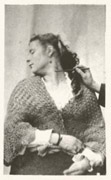
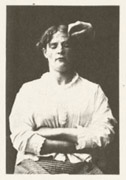
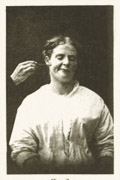
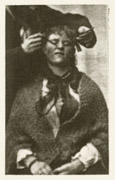
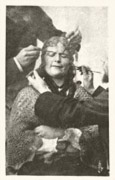
Journal : Archives de Neurologie, vols. ii., iii., v.
Paris : Bureaux du Progrès Médical, 1881-1883.
Description : Vol. 2., pp. 32-75 ; v. 2., pp. 173-215, [5 l.] pl. ; v. 3., pp. 129-141 ; v. 3., pp. 310-319 ;
vol. 5., pp. 307-323 ; ill.: 20 photos., woodcut figs. ; 22 cm.
Photographs : 20 photographs on 5 leaves (process unverified).
Photographer : Loreau.
Subject : Hypnosis — Contracture.
Notes :
MM. CHARCOT and RICHER, in a contribution to the study of Hypnotism in Hysterical Patients (Le Progrès Médical, Nos. 15, 16, 1881), draw attention to the phenomenon of exaggerated excitability of the nerves and muscles during certain forms of induced sleep. This phenomenon includes (1) great increase in the tendon-reflexes ; percussion on a tendon giving rise to movements not only in the same limb but in the others, to sharper reflex contraction, to prolonged contraction, and to permanent contraction ; the contraction may be brought about by kneading, friction, or simple pressure; (2) increased nervous excitability: pressure on nerve-trunks giving rise to spasm of the muscles to which their branches are distributed ; (3) increased muscular excitability ; pressure on muscle causing it to contract ; (4) a special increased excitability of the muscles of the face, which cannot be thrown into permanent spasm, but may be excited in any of the foregoing ways, and even by simply pressing each one with a small piece of wood, by which means they reproduced most of the experiments of Duchenne of Boulogne, on the partial action of the muscles of the face under the influence of localized faradisation.
The contraction resulting as above described is generally very intense, resisting the most forcible efforts to overcome it, but it may be made to yield, without force, by simply stimulating in the same manner the antagonist group of muscles. When the contraction is not destroyed during the hypnotic sleep, on awakening the patient, the contraction may disappear with the sleep ; or it may persist after waking, if we render the patient cataleptic and awaken her during that state ; or it may in some cases persist whether the patient be awakened during either the lethargic or the cataleptic state. Such persistent contractions resemble those of hysteria ; and for their reduction it is necessary to hypnotize the patient again, and then to excite the antagonist muscles.
The transference of artificial contraction by means of the magnet is well known, since the experiments at the Salpêtrière in 1878 ; but it was not known whether such transferred contraction affected exactly the same muscles as were involved in the primary contraction. One of the patients of MM. Charcot and Richer having been hypnotized, and her muscles completely relaxed, the ulnar group were stimulated by touching the right ulnar nerve at the elbow, and a magnet was then applied to the left arm, the muscles of which remained relaxed ; at the end of two or three minutes the fingers of the contracted hand began slowly to open, while those of the opposite hand began to assume the position they were quitting, until the contraction was completely transferred. The same result followed when localized contraction was induced by exciting a tendon or the muscle itself.
Anmia of a limb produced by Esmarch's bandage prevents the manifestation of contraction, so long as the anemia persists ; but as the blood returns to the limb the contraction shows itself. In the former stage, therefore, it may be considered to be latent. This latent contraction may also be transferred by the magnet ; so that, while in the bloodless limb no contraction results from exciting the nerve, a magnet applied to the opposite arm develops in it the spasm of the ulnar group of muscles. London Med. Record, June 15, 1881.
Photographer caption: "Nous devons cette collection de photographies au concours habile de M. Loreau, modeleur du musée anatomo-pathologique de la Salpêtrière."





This paper is a continuation of Charcot's research into psychogenic contracture which he began after the Franco-Prussian war of 1870-1871. In 1878 he introduced the technique of hypnotism into this research, launching into what is often referred by historians as "Charcot's third career." It was his most controversial and least understood work and even today scholars and historians err by framing this chapter in the life of Charcot — the brilliant Napolean of Salpêtrière — exclusively with the terms of dynamic psychiatry. It was research, however, that was momentous and consequential to his earlier work in neurophysiology and it is being replicated in brain labs today. Charcot was absolutely correct by postulating an organic basis to psychic disorders.
